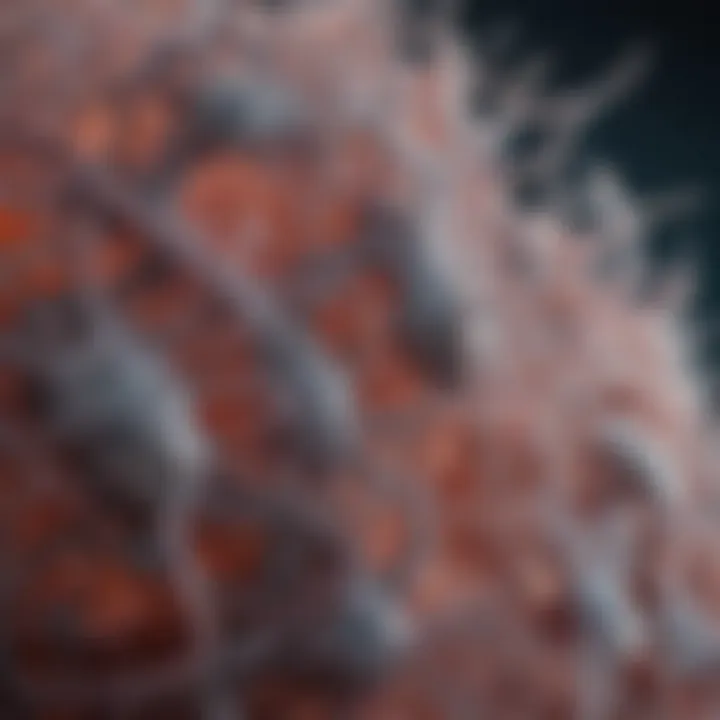Managing Morgellons: Insights and Strategies


Intro
Morgellons disease is an enigmatic condition that continues to perplex both patients and healthcare professionals alike. It is characterized by a range of unusual and often distressing symptoms, including sensations of crawling or itching, as well as the presence of fibers or particles on or under the skin. This condition poses unique challenges in its diagnosis and management, often leading to considerable confusion and stigma for those affected. Despite ongoing debates about its classification and legitimacy in the medical community, it crucially impacts the lives of many individuals.
In this article, we will systematically explore Morgellons by examining its symptoms, potential causes, and the psychological implications faced by patients. Management strategies will also be discussed to provide valuable insights that can support both individuals living with the condition and the healthcare providers attending them. The complexities surrounding Morgellons not only require a deep understanding of its clinical aspects but also a compassionate approach towards the experiences of those living with it.
Article Overview
Summary of Key Findings
This article emphasizes that Morgellons is not merely a skin condition; it involves both physiological and psychological elements. Key findings suggest:
- Morgellons manifests through skin sensations, fibers, and other related symptoms.
- Patients often report feelings of being misunderstood or invalidated by medical professionals.
- There is an ongoing debate surrounding its classification, competing between somatic symptom disorder and potential infectious or environmental causes.
Research Objectives
The objectives of this research are to:
- Clarify the symptoms commonly associated with Morgellons.
- Investigate the interplay between psychological and physical aspects of the condition.
- Evaluate current management strategies and their effectiveness.
- Provide a platform for healthcare professionals to better understand patient experiences.
Key Results and Discussions
Main Findings
The findings reveal that patients with Morgellons may experience:
- Persistent itching and crawling sensations that can lead to skin lesions.
- The presence of various fibers or granules, which are often described as colored or transparent.
Additionally, a significant psychological component is often reported:
- Many individuals express feelings of isolation due to the skepticism surrounding their condition.
- Some studies suggest that anxiety and depression are prevalent in the Morgellons population.
Implications of Findings
The implications of these findings underscore the necessity for healthcare professionals to approach Morgellons with an open mind. The lack of consensus in the medical field regarding its classification calls for:
- Increased awareness and education for both patients and providers.
- Further research into the psychological and physiological dimensions of the condition.
- Empathetic communication strategies to support affected individuals and reduce stigma.
Morgellons is multifaceted, demanding nuanced discussions that take into account the complexity of the human experience.
Foreword to Morgellons
The study of Morgellons is crucial, as it addresses a condition that remains largely misapprehended both within the medical community and society at large. Morgellons disease, marked by unexplained skin sensations and the emergence of fibers, calls for a nuanced understanding. This section serves to lay foundational knowledge, helping readers grasp the complexity of symptoms and experiences associated with the condition.
Defining Morgellons
Morgellons is a condition noted for intriguing and unsettling symptoms, primarily affecting the skin. Patients report sensations of crawling, stinging, and itching. In addition to these sensations, many individuals find the presence of fibers or particles on their skin or within lesions. The definitional aspect of Morgellons remains contentious. While some consider it a form of delusional parasitosis, a condition where patients believe they are infested by parasites, others advocate for its legitimacy as a distinct medical issue. This discrepancy in definitions has led to varied approaches in management and treatment.
Historical Background
The history of Morgellons spans several centuries, documenting differing perspectives on its existence and understanding. The term itself was first introduced in the medical literature by Mary Leitao in 2002. However, references to similar symptoms can be found as far back as the 17th century. These references often describe similar sensations experienced by individuals, reflecting a thread of continuity in human health experiences. Over time, perceptions of Morgellons have evolved, yet it remains a subject of debate.
Many healthcare professionals remain skeptical, leading to dismissal of patients' experiences. This skepticism has fostered a sense of isolation for those diagnosed or experiencing Morgellons, leading to significant emotional distress. Understanding the historical context allows for greater empathy and support in managing this multifaceted condition.
"Morgellons may not only be a physical ailment; it signifies a profound emotional experience that warrants attention."
Such insights can improve the overall care strategy for individuals grappling with Morgellons. Consequently, recognizing its history is essential for both healthcare providers and patients so they can effectively navigate the challenges presented by this condition.
Symptoms of Morgellons
Understanding the symptoms of Morgellons is essential for both patients and healthcare providers. The manifestations of this condition may significantly impact the quality of life of those affected. Recognizing these symptoms leads to better management strategies and ultimately more effective treatment options. This section breaks down the distinct symptoms into two main categories: skin manifestations and neurological symptoms, both of which are interconnected yet require separate considerations for management.
Skin Manifestations
Skin manifestations of Morgellons are among the most prominent symptoms and are crucial in the diagnostic journey. Patients often report varying sensations and visual abnormalities associated with their skin, making this aspect particularly relevant for understanding the condition.
Itching
Itching stands out as a primary complaint among individuals with Morgellons. This sensation can be severe and persistent, contributing substantially to discomfort and distress. It often leads to scratching, which can result in skin damage and secondary infections.
The key characteristic of itching is that it can become debilitating for patients. Many individuals may find no relief from conventional treatments, which adds to their frustration. The uniqueness of itching in Morgellons is that it sometimes occurs without visible lesions, leading to confusion and a sense of isolation for those affected. This aspect makes it a significant focus in both patient narratives and clinical evaluations.
Unlike other conditions causing pruritus, Morgellons-related itching is subjective; its intensity cannot always be measured through typical clinical assessments. As such, it presents challenges for healthcare professionals to believe and validate patients' experiences.
Sores
Sores are another critical symptom experienced by many with Morgellons. These skin lesions can vary from small areas of irritation to larger, more painful sores. They often arise from scratching or the body's natural response to perceived irritants.
The key characteristic of sores is their variability in presentation. Some are crusted or oozing, while others resemble excoriations but do not follow a clear infectious pattern. This feature makes sores a focal point for understanding the physical consequences of the condition. Patients often report that these sores worsen their emotional and psychological struggles, as they can be visible and affect their self-esteem.
Understanding sores aids in recognizing the severity of the disease and tailoring suitable management strategies. However, their unpredictable nature can complicate effective treatment, as many over-the-counter options may prove inadequate.
Fiber Production
The production of fibers is perhaps the most distinct symptom associated with Morgellons. Individuals often report finding fibers or particles on their skin or within lesions. These fibers can be various colors and textures, adding to the surreal experience of this condition.


The key characteristic of fiber production is its enigmatic nature. Discussion surrounding it often sparks skepticism both among medical professionals and the general public, as the origin of these fibers is not fully understood. Despite the confusion, many patients believe these fibers are a core component of their symptoms, linking them to feelings of being unwell.
Because they are not typically recognized in dermatology or pathology, fiber manifestations can lead to unnecessary stigma and isolation. Thus, exploring these fibers contributes significantly to the clinical understanding and management of patients with Morgellons.
Neurological Symptoms
Neurological symptoms in Morgellons cover a range of experiences that can deeply affect cognitive function and sensory perception. Recognizing these symptoms is vital for holistic management and understanding how they intertwine with skin manifestations.
Cognitive Impairments
Cognitive impairments reported by Morgellons patients often encompass difficulties with memory, attention, and overall mental clarity. This aspect can severely affect daily functioning and quality of life. Patients may describe foggy thinking or moments of forgetfulness, adding to their distress.
The key characteristic of cognitive impairments in Morgellons is that they do not easily fit within a defined medical framework. This uniqueness makes it harder for providers to diagnose and treat effectively. Studies suggest that these cognitive challenges may arise from chronic stress or anxiety related to the condition, indicating an interplay between physical and mental health.
Thus, addressing cognitive impairments is not just about symptom management but also about supporting mental wellness during treatment.
Sensory Disturbances
Sensory disturbances, including altered perceptions of touch, pain, and temperature, can lead to further complications for Morgellons patients. These disturbances create additional layers of discomfort, complicating the patient's experience.
The key characteristic of sensory disturbances is their unpredictability. They can fluctuate in intensity, making it difficult for patients to predict when symptoms might worsen. Many feel uneasy or anxious due to this inconsistency, further impacting their mental health.
This unique challenge emphasizes the need for comprehensive care strategies that address both physical and psychological aspects of Morgellons. Doctors should carefully consider these symptoms when devising treatment plans, incorporating interventions that help manage both domains.
Possible Causes of Morgellons
Understanding the possible causes of Morgellons is crucial for comprehending this complex condition. Many patients experience a range of symptoms that often lead to seeking various medical opinions. Identifying underlying causes may assist in better management and treatment. A detailed overview of the possible causes can also help health-related professionals gain insight into Morgellons and approach it with informed perspectives.
Infectious Agents
Bacterial Hypotheses
Bacterial hypotheses present a compelling angle in exploring the causes of Morgellons. Some researchers propose that bacteria may play a role in manifesting symptoms, particularly in the skin. One significant characteristic of this hypothesis is its suggestion that certain bacteria trigger or exacerbate the skin anomalies seen in patients. This viewpoint is beneficial for this article because it encourages a deeper examination of microbial influences on human health.
A unique feature of bacterial hypotheses is the investigation into specific bacteria, like Borrelia burgdorferi, linked to Lyme disease, which has shown associations with Morgellons symptoms. However, the challenge lies in establishing direct causation versus correlation. While some patients report opportunities for improvement through antibiotic regimes, the evidence remains inconclusive. The advantages of highlighting this hypothesis are the potential leads for treatment options, yet disadvantages include an ongoing debate within the medical community on this aspect.
Parasitic Involvement
Parasitic involvement also remains a focal point in the possible causes discussion. Some suggest that parasitic infections may contribute to or mimic Morgellons symptoms. Its key characteristic stems from the notion that these organisms can provoke skin irritation and sensations similar to those reported by patients. By including this perspective, this article allows for expanded dialogue about various conditions that might influence Morgellons.
The unique feature of this discussion involves exploring recognized parasites such as Demodex mites. Some argue these parasites may play a contributing role to the skin sensations noticed in Morgellons patients. While some anecdotal evidence appears to support this, controlled studies remain limited. The advantage of considering parasitic involvement lies in broadening treatment possibilities, but the disadvantage is the potential misdiagnosis or overdiagnosis of parasites when other factors might be responsible.
Environmental Factors
Toxic Exposures
Toxic exposures are another crucial aspect to review. The discussion surrounding environmental toxins centers on how chemicals and pollutants in the environment may affect skin health and neurological functions. This hypothesis suggests a relationship between Morgellons symptoms and toxic agents in one’s surroundings. Such a consideration is vital for understanding the multifaceted nature of the condition.
A key characteristic of focusing on toxic exposures is the acknowledgment of modern environmental challenges that people face daily. Certain pollutants or chemical ingredients found in common household products might aggravate symptoms. The inclusion of this topic allows for examining preventative measures individuals can take. However, determining direct causation can be problematic as various factors contribute to environmental health.
Lifestyle Influences
Lifestyle influences encompass various factors, from stress to diet, that may affect overall health and potentially exacerbate Morgellons symptoms. This topic carries importance since lifestyle changes may offer avenues for symptom relief. The core characteristic here relates to personal choices and their links to health outcomes.
One unique feature of lifestyle influences is their variability; everyone experiences different levels of stress, sleep, and nutritional habits. Changing some of these lifestyle factors could minimize the experience of symptoms for some patients. The advantage lies in the focus on empowerment for patients to take charge of their condition, but the disadvantage involves the subjective nature of lifestyle influences and their contribution to the seriousness of symptoms.
Psychosomatic Considerations
Psychological Impact
The psychological impact on Morgellons patients cannot be overlooked. Mental health factors frequently exacerbate physical symptoms, leading to a cycle of distress. A key aspect of this discussion involves understanding how emotional well-being intersects with physical health. This narrative is valuable for this article as it emphasizes the importance of an integrated approach to treatment.
The unique aspect of focusing on psychological impact includes acknowledging how stress, anxiety, and depression may amplify patients' experiences of discomfort. While recognizing psychological factors can offer some paths for interventions, the challenge arises in ensuring these factors do not overshadow the physical symptoms necessary for treatment.
Societal Stigmas
Societal stigmas further complicate the lives of individuals with Morgellons. This issue addresses how public perception affects those diagnosed and their access to resources and compassion. The key characteristic of examining societal stigmas lies in identifying biases that prevent proper recognition and treatment of the condition.
A unique feature of discussing societal stigmas is its potential to unify patients and advocates in calling for better awareness. Identifying this barrier allows for creating strategies that aim to dismantle misconceptions and enhance understanding of Morgellons. However, the disadvantage consists in the slow process of changing societal views that might delay support for those suffering from this condition.
Through exploring the possible causes of Morgellons, this article aims to provide a cohesive understanding of the various dimensions affecting those who experience this condition. Recognizing infections, environmental factors, and psychological influences can help illuminate paths for further research and effective patient management.
Psychological Perspectives
Understanding the psychological dimensions of Morgellons is crucial. This condition impacts not only the physical well-being of patients but also their mental health. Psychological perspectives allow for a more comprehensive approach to treatment and management, encompassing the emotional and cognitive challenges faced by individuals. It is important to recognize that psychological factors can influence symptom perception, severity, and overall patient experience.
Mental Health Associations
Anxiety and Depression
Anxiety and depression are common comorbidities in patients with Morgellons. These mental health conditions can exacerbate physical symptoms and may lead to a cycle of distress. In this article, we emphasize the role of anxiety and depression because they significantly affect how individuals interpret and cope with their symptoms.
A key characteristic of anxiety is its tendency to amplify worries about one’s health, which can make Morgellons feel more severe. Many patients report a heightened sense of fear regarding their symptoms, fearing they may indicate a more serious underlying condition. This fear can lead to increased stress, ultimately worsening the experience of Morgellons. Meanwhile, depression often manifests as a loss of interest or pleasure in daily activities. Patients may struggle with feelings of hopelessness, impacting their quality of life.
The unique features of anxiety and depression in the context of Morgellons include a strong psychological burden and the potential for social withdrawal. Addressing these mental health issues is not only beneficial but essential. It leads to improved patient outcomes and aids in the effective management of Morgellons symptoms.
Somatic Symptom Disorder


Somatic Symptom Disorder (SSD) involves the presence of physical symptoms that cause significant distress or impairment, without a clear medical explanation. This aspect is vital in discussing Morgellons, as many patients experience symptoms that are difficult to explain through traditional medical models.
A key characteristic of SSD is the focus on the distress rather than the symptoms themselves. Patients with Morgellons may seek medical help repeatedly, often not receiving the validation they desire. This is why discussing SSD in relation to Morgellons offers deeper insights into the patient experience. It allows us to bridge the gap between mental and physical health, highlighting how mental processes can shape the understanding of one’s physical condition.
The unique feature of SSD includes the potential for increased stigma and misdiagnosis in patients with Morgellons. The implication is that these individuals may be viewed skeptically by healthcare professionals, which can further exacerbate feelings of isolation. Considering SSD when discussing Morgellons enhances our ability to manage these patients effectively, ensuring that their psychological needs are met while addressing their physical complaints.
Patient Experiences and Narratives
Patients often describe their journeys with Morgellons in unique and personal ways. These narratives shed light on how this condition affects daily life. Reports of feeling misunderstood and dismissed by healthcare providers prevail, leading to a sense of alienation. Individuals articulate the struggle not only to find effective treatment but also for validation of their experiences. These stories are important for fostering empathy and understanding in the medical community. Moreover, they highlight the need for a more inclusive approach that considers individual experiences as part of the healing process. Patient narratives can serve as powerful evidence for the complexity of Morgellons, encouraging a more nuanced understanding of the condition.
"My symptoms are real, even if the doctors don't understand them. Every day is a challenge that I must navigate alone."
Engaging with these experiences could help shape future research and management strategies, providing a clearer picture of the psychological underpinnings associated with Morgellons.
Challenges in Diagnosis
The diagnosis of Morgellons presents a complex challenge for both patients and healthcare professionals. This multifaceted condition is often characterized by a variety of symptoms that can overlap with other medical issues. The lack of consensus on its classification exacerbates the diagnostic difficulties. Understanding these challenges is crucial to providing effective care and support.
Differential Diagnosis
Differential diagnosis plays a critical role in the management of Morgellons. Symptoms such as skin lesions, fiber-like structures, and varied neurological symptoms can mimic other medical conditions. As a result, practitioners must conduct thorough assessments to rule out diseases like psoriasis, eczema, and even mental health disorders.
Some key factors in conducting a differential diagnosis include:
- Patient History: Gathering detailed information about the patient’s medical background, lifestyle, and environment can provide crucial insights.
- Clinical Examination: A careful evaluation of physical symptoms may help in identifying co-existing conditions.
- Diagnostic Tests: Blood tests, skin biopsies, or other assessments might be employed to further clarify ambiguous symptoms.
Accuracy in diagnosing Morgellons is essential for effective treatment planning. Consequently, healthcare providers often face the need to balance thoroughness with the risk of subjecting patients to unnecessary tests.
Skepticism in the Medical Community
Skepticism toward Morgellons within the medical community adds layers of complexity to the diagnosis. Some healthcare professionals regard Morgellons as a psychosomatic disorder rather than a distinct physical ailment. This perspective can lead to dismissive attitudes, thereby affecting how patients are treated.
Factors fueling skepticism include:
- Limited Research: Scientific studies addressing Morgellons are currently sparse. This lack of robust evidence leads some to question the legitimacy of the condition.
- Varied Patient Experiences: The range of symptoms reported by patients makes it difficult to establish a clear and consistent medical profile for Morgellons.
- Psychosocial Elements: Many practitioners note the psychological factors that seem to be linked to Morgellons symptoms, further complicating its classification.
Despite such skepticism, it is essential to approach Morgellons with an open mind. Acknowledging its impact on patients’ lives is necessary for delivering empathetic care. Building a dialogue between medical professionals and patients can facilitate better understanding and ultimately improve diagnostic accuracy.
"Understanding patient experiences is as critical to diagnosis as medical tests and history taking."
Management Strategies
The management of Morgellons disease presents a unique challenge. Due to the complex and multifaceted nature of this condition, effective management strategies must be both comprehensive and tailored to the individual’s needs. This necessitates a coordinated approach that includes medical and psychological support, which is crucial for addressing both physical symptoms and the mental burden often associated with Morgellons. In this section, we delve into two primary strategies: multidisciplinary approaches and patient-centered care. Both play a vital role in optimizing outcomes for patients.
Multidisciplinary Approaches
Role of Dermatologists
Dermatologists are often the first point of contact for patients experiencing symptoms consistent with Morgellons. Their expertise in skin disorders makes them uniquely positioned to evaluate and treat the dermatological manifestations of this condition. A key characteristic of dermatologists is their focus on skin health, which enables them to provide targeted treatment for issues like itching, sores, and fiber production.
The benefit of involving dermatologists in management lies in their ability to offer medical interventions, such as topical treatments or referrals for other therapies. However, a unique feature of their role is also the need for collaboration with mental health professionals. While dermatologists can address physical symptoms, they may not always fully appreciate the psychological impact of the disease experienced by patients. One possible disadvantage includes the risk of patients feeling dismissed if their symptoms do not conform to traditional dermatological diagnoses.
Involvement of Psychiatrists
Psychiatrists bring a crucial perspective to the management of Morgellons. This involvement is particularly important given the mental health components associated with the condition. Psychiatrists can assess and treat anxiety, depression, and other psychological issues that may arise. Their key contribution is their understanding of the complex interactions between physical and mental health, recognizing that many patients may experience emotional distress that exacerbates their perceived symptoms.
Involvement with a psychiatrist is often seen as beneficial because they can offer therapeutic approaches tailored to the individual’s experience. Additionally, they might prescribe medications like antidepressants that can help alleviate some of the emotional burdens tied to Morgellons. However, a unique challenge within this collaboration includes the societal stigma surrounding mental health, which can hinder patients from seeking necessary support.
Patient-Centered Care
Support Groups
Support groups serve as an essential component of patient-centered care for those grappling with Morgellons. These groups allow individuals to share experiences and emotions in a safe space, significantly enhancing their coping mechanisms. The key characteristic of support groups is the community they foster, providing patients with a sense of belonging and understanding.
Participants often find that discussing their challenges can relieve feelings of isolation. In many cases, knowing that one is not alone in their battle can be incredibly empowering. However, a possible disadvantage is that not all support groups are facilitated by professionals, which can lead to misinformation or unverified treatments being discussed.
Therapeutic Interventions
Therapeutic interventions are vital in addressing both the psychological and physical aspects of Morgellons. These interventions may include cognitive behavioral therapy, exposure therapy, and mindfulness practices aimed at reducing anxiety and enhancing emotional well-being. A key characteristic of these therapies is their focus on the individual’s overall mental health, which can translate into physical symptom management as well.
These approaches often provide practical tools for patients, helping them navigate their symptoms more effectively. The benefit of these interventions is noted in their adaptability; they can be tailored to meet the unique needs of each patient. However, a potential disadvantage here is that not every patient may respond positively to these therapies, highlighting the necessity for ongoing adjustments to treatment strategies as needed.
Treatment Modalities
Treatment modalities for Morgellons disease are essential. They include various methods and interventions that aim to alleviate symptoms and improve the quality of life for those affected. As the condition is often misunderstood, a broad range of treatment options becomes crucial for addressing the diverse symptoms experienced by patients.
The focus on diverse treatment modalities allows clinicians and patients to tailor approaches based on individual needs, symptoms, and preferences. This flexibility enhances patient engagement and compliance, as individuals are more likely to follow treatment plans that consider their unique circumstances.
Medications
Medications are a critical component of managing Morgellons, with a focus on providing relief from distressing symptoms. Both topical treatments and antidepressants provide avenues for intervention.
Topical Treatments
Topical treatments are often the first line of defense for skin-related symptoms. These treatments include creams, ointments, and other formulations designed to address itching and irritation. The key characteristic of topical treatments is their localized effect, which makes them beneficial for managing surface-level symptoms effectively.


These treatments can include corticosteroids or antipruritic agents that reduce inflammation and irritation, bringing relief to affected areas. A unique feature of topical treatments is their direct application, allowing for a high concentration of medication at the site of symptoms.
However, there are disadvantages. Patients may experience skin sensitivities or reduced effectiveness over time. It’s important for individuals to monitor their reactions and communicate with healthcare providers.
Antidepressants
Antidepressants can play a supportive role in managing the psychological aspects of Morgellons. Many patients report anxiety and depression, which can be exacerbated by the condition. The key characteristic of antidepressants is their ability to modify mood and emotional responses. They help individuals cope with the distress associated with their symptoms.
Common types include selective serotonin reuptake inhibitors (SSRIs). These medications can contribute to improved mental health and overall well-being, making them popular choices in treatment plans. A distinctive feature of antidepressants is their potential to address both mental and physical symptoms, offering a dual benefit.
However, these medications can also have side effects, such as weight gain or fatigue. Patients must work closely with their healthcare provider to determine the most suitable option.
Alternative Therapies
Alternative therapies can provide additional avenues for individuals seeking holistic approaches to managing Morgellons. Often, these methods complement traditional treatments.
Dietary Approaches
Dietary approaches focus on nutrition and the impact of food choices on overall health. Emphasizing a balanced diet can help improve immune function, which is significant for managing symptoms. The key characteristic of dietary approaches is their focus on prevention and wellness.
A unique feature is the potential for personalized dietary changes; every individual can adapt their diet to their unique health needs. This approach can be beneficial, but it requires diligence in making healthy choices. Some may find it difficult to follow strict dietary regimens or may not notice a significant impact on their symptoms.
Complementary Practices
Complementary practices include various methods such as acupuncture, yoga, and meditation. These practices aim to promote relaxation and reduce stress, which can be beneficial for those living with Morgellons. The key feature is their focus on the mind-body connection.
A unique aspect of complementary practices is the broad range of options, allowing individuals to find what resonates with them personally. However, these approaches may not yield immediate results and typically require consistent effort over time.
Current Research Trends
Research in Morgellons disease is continually evolving. Understanding the latest findings is crucial for clinicians, patients, and researchers alike. Current trends focus on clinical studies and emerging theories. These areas offer insights into the underlying mechanisms of the condition, which may lead to better management strategies.
Clinical Studies
Clinical studies play a vital role in understanding Morgellons. Researchers are examining the symptoms and potential causes more closely. For instance, studies often gather data through surveys and interviews, helping identify common factors among patients. By analyzing this data, researchers aim to recognize patterns and associations that could shed light on Morgellons' etiology.
Recent studies have also started exploring treatment efficacy. This includes various medications and therapies to see how they affect the symptoms of Morgellons. Assessing patient responses to these interventions can help establish a more focused approach to treatment. Many of these studies include diverse patient groups, enhancing the reliability of the results.
Emerging Theories
Emerging theories are reshaping how we view Morgellons. One prominent idea is the role of microbiomes in skin health. Alterations in skin flora may contribute to the manifestations of Morgellons. Additionally, some researchers propose neurobiological links that could explain the sensations reported by patients. These theories prompt further investigation, aiming to connect these observations to wider health implications.
Another theory suggests that Morgellons may have a systemic component, indicating that the condition extends beyond the skin. This could involve inflammatory responses or autoimmune reactions. Understanding these connections can offer new avenues for research and treatment.
As the science of Morgellons advances, these theories invite an interdisciplinary approach, encouraging collaboration across fields.
Future Directions in Morgellons Research
As research progresses on Morgellons disease, the exploration of future directions becomes critical both for understanding the condition and for improving management strategies. There is a pressing need for rigorous studies to validate the experiences reported by patients. These experiences often include unexplained skin sensations and the visual presence of fibers or particles. Innovations in research methodology can reveal vital insights into the mechanisms underlying Morgellons, ultimately leading towards more effective treatment options.
Need for Standardized Protocols
Standardized protocols for research on Morgellons disease are essential for several reasons. First, they allow for the replication of studies across different settings and populations. This is crucial to establish reliability in findings. When studies use varying criteria for diagnosis or assessment, it becomes challenging to compare results and draw meaningful conclusions. Such inconsistencies can hinder the development of a solid evidence base that informs clinical practice.
Furthermore, standardized protocols can facilitate interdisciplinary research efforts. By establishing common terms and methodologies, researchers from various fields, including dermatology, psychology, and environmental sciences, can collaborate more effectively. This collaboration is vital, as Morgellons likely has multifaceted causes, involving both biological and psychological components.
Some key aspects of what these standardized protocols might include are:
- Clear diagnostic criteria: To define what constitutes Morgellons disease clearly.
- Consistent symptom assessment tools: For measuring the severity and impact of symptoms on patients.
- Longitudinal studies: To track changes over time in symptoms and treatment response.
Interdisciplinary Collaboration
Interdisciplinary collaboration is an important element in advancing our understanding of Morgellons disease. Collaboration across medical disciplines can bring diverse perspectives that are vital to tackling this complex condition. For example, dermatologists can offer insights into skin symptoms while psychologists can shed light on the emotional and mental health aspects.
Such collaboration could potentially yield innovative approaches to treatment and management. One area of interest is the potential overlap between Morgellons and conditions such as fibromyalgia or other chronic pain syndromes. By pooling knowledge from various specialties, researchers can explore whether shared pathophysiological mechanisms exist.
Key considerations for fostering interdisciplinary collaboration include:
- Regular workshops and conferences: To bring together experts from different fields for direct communication.
- Joint funding applications: To support research that addresses Morgellons from multiple angles.
- Shared databases: That allow clinicians and researchers to access findings and case studies efficiently.
End
The conclusion of this article highlights several critical components surrounding Morgellons disease. It underscores the multifaceted nature of this condition, which is often overlooked or misunderstood. By synthesizing the previous sections, the conclusion reinforces the significance of a comprehensive approach to managing Morgellons. This involves not only recognizing the symptoms and possible causes but also understanding the psychological implications and management strategies.
Summary of Key Points
In summarizing the key points, it is important to reiterate the core aspects discussed throughout the article. Some highlights include:
- Defining Morgellons: Understanding what it is and its historical context.
- Symptoms: Noteworthy skin manifestations and neurological symptoms help paint a clearer picture of patient experiences.
- Possible Causes: Exploring infectious agents, environmental factors, and psychosomatic considerations.
- Management Strategies: The necessity for multidisciplinary approaches tailored to individual needs.
- Treatment Modalities: Overview of medications and alternative therapies applicable to Morgellons patients.
- Current Research and Future Directions: Emphasis on the need for standardized protocols and interdisciplinary collaboration to enhance understanding and care.
This summary serves to remind readers of the complexity surrounding Morgellons and the importance of viewing it from various angles – medical, psychological, and social.
Final Thoughts on Management
In closing, managing Morgellons requires a holistic understanding of the condition. It is not solely a medical issue; it also incorporates experiences of patients, their mental health, and societal perceptions. By advocating for patient-centered care, healthcare professionals can foster an environment conducive to healing and understanding.
Investing in research will remain crucial as it can lead to advancements in treatment options and protocols. Equally, ongoing dialogue and support from healthcare providers can significantly uplift patient morale and promote better management outcomes.
Ultimately, the journey of managing Morgellons is complex. Still, a well-rounded approach, underscored by continuous education and support, can create pathways for effective coping mechanisms for those afflicted.
"The understanding and treatment of Morgellons require an open mind and tailored strategies to address the unique experiences of each patient."
By reframing the discourse around Morgellons, stakeholders can contribute to better-informed health policies, research priorities, and support networks that genuinely meet the needs of those living with this perplexing condition.







